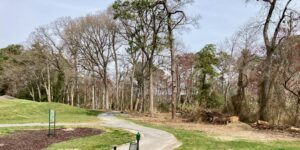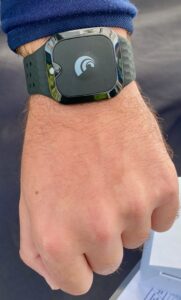Going for the flow
April 14, 2023
The original design for The Greens at Broadview golf course near Milton called for a wide swath of trees to be removed to create a fairway for the 5th green along the eastern edge of the property.
Then they discovered what was in those woods.
Much of the area was a seasonal wetland which had to be avoided. It was also a heron rookery.
That inspired the owners to rename the golf course to The Rookery, as we now know it.
The 5th green’s location did not significantly change, however, set in a recessed open spot south and west of the forest and near a hedge row. The remaining hedge row trees create challenges for approach shots, but the thick woods to the side and behind the green caused a different problem for course management.
The microclimate there can be stuffy, with limited air movement and a long morning shadow before the sun rises enough to clear the tree line and light up the green. That could easily lead to poor turf health during hot and humid conditions – like a Cape Region spring and summer.
The inability to clear the forested area due to wetlands/rookery issues is why a large fan stands just behind the green at its northeast corner. The fan blows over the green and keeps the turf cooler, drier, and less receptive to disease and other problems.

Cleared area behind the 12th green and 13th tees at The Rookery
Rookery co-owner Chris Adkins said, “The fan turned 5 green from a problem green to one of the best greens. Air flow is critical.”
The Rookery management recently took a different approach to a similar condition behind the 12th green and the 13th tee boxes. Big equipment cut down and shoved aside a wide swath of trees and thick undergrowth.
It’s not pretty, but the area should soon green up a bit.
Course superintendent Mike Pyne said the area needed clearing. Installing another fan was not an option, so he and his staff used the tools at hand instead.
The additional open space should improve air flow, add more sunlight earlier in the day, and help the turf grass remain in good shape throughout the challenging summer season. This relatively passive approach to maintenance could also reduce the need for chemical treatment alternatives.
Changes at Bayside Resort
Congratulations to Eric Mason for his recent promotion to Director of Golf at Bayside Resort Golf Club in Selbyville. The PGA professional earned his PGM credentials at the University of Maryland – Eastern Shore, and has worked for Troon for several years, including a stint at Bear Trap Dunes.
Bob Crowther, the longtime golf director at Bayside and a past head golf professional at Cripple Creek Country Club, has become Bayside’s Director of Golf Education.
deWiz golf trainers: the power of touch
During a teaching session years ago, Rookery head golf pro Kyle Deas stood behind me where I could not see him, holding a golf club at the iron end. When my backswing went too far, he would tap my club with his iron at the point where I should have stopped.
Seven straight taps later, we took a break. We eventually figured out what part of my swing I could see, feel, and use (left shoulder under chin) to stop the tapping and fix my problem.
deWiz Golf took a similar sensory-based approach to golf instruction and digitized it, with increasing market acceptance and success.
At the 2023 PGA Show’s Demo & Fitting Day in January I met Matt Lawrence, a social content media manager for the Swedish company, to go over the device’s features and uses.
Worn on the wrist, the deWiz motion detector captures the lead arm and hand movement throughout the golf swing, transmitting geodata via Bluetooth to the company’s app on a nearby mobile device.
On the bottom of the watch-like device are two metal discs called “stimuli plates.” Golf coaches and/or the player can set location parameters for when these plates will transmit an electronic signal pulsing through the player’s skin.
There are seven levels of feedback intensity which can be adjusted with the app.
The deWiz device has no watch face. The results are shown on the app’s display.
Among other options, it measures the length of the backswing, transition movement, tempo, maximum hand speed achieved, backswing plane, time from start to impact, and backswing width. Swing coaches use the data to help players adjust their movements and improve their results.
Lawrence gave an example of how one touring professional uses the device in his training routines. The pro sets the deWiz at the highest feedback pulse, to be triggered within a one-inch variance on either side of his intended backswing length, for a partial wedge shot of 90 yards. The intensity of the deWiz pulse helps speed up the process of cementing the desired swing length into the player’s routine. As Lawrence said, “he doesn’t want to feel that!”
The deWiz system is not cheap, retailing at $699.00 SRP with a discount and reseller program available for teaching pros.
For golfers who are serious about their game, however, the deWiz can be well worth the investment.
Local club competition results
The Mulligan’s Pointe Ladies played a Nassau game April 11.
In the first division, Valerie Gibb won the front nine, with Kathy Hidalgo in second. Wendy Michaelson won the back nine, with Retta Rose Frampton in second. Brenda Joyce won the full 18, followed by Karen Feuchtenberger.
Dottie Pope won the front nine in the second division, with Bonnie Quesenberry in second. Jackie Chenuta won the back nine, with Pam Pichola in second. Deb Molenski won the full 18, followed by Susan Shockley.

